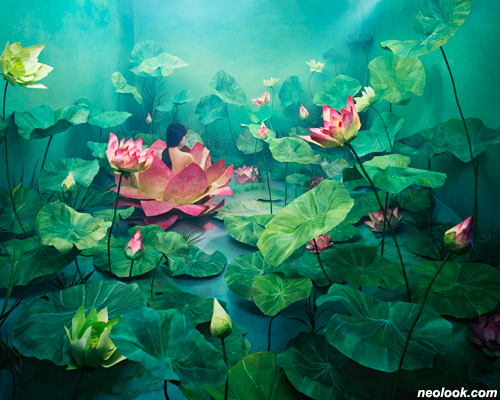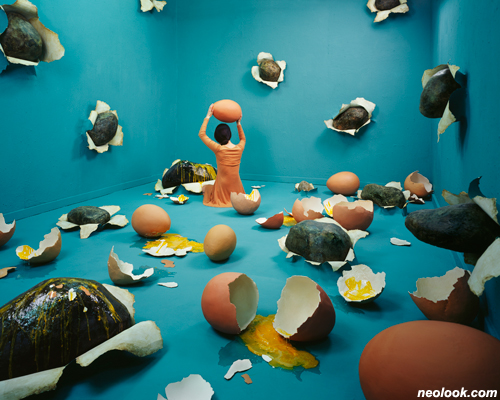- ● homepage
- ● archives
- ● restoration
- ● books
- ● big banners
- ● post board
- ■ neo's search
- ■ about us
- ■ 게재방법 안내
- 개인정보처리방침

- [email protected]
- Tel. 02_335_7922
- Fax. 02_335_7929
- 10:00am~04:30pm
- 월요일~금요일
- 3/3(월) 대체공휴일

Stage of Mind
이지영展 / LEEJEEYOUNG / 李知盈 / photography 2011_0512 ▶ 2011_0529 / 월요일 휴관
● 위 이미지를 클릭하면 네오룩 아카이브 Vol.20090422c | 이지영展으로 갑니다.
초대일시 / 2011_0512_목요일_06:00pm
관람시간 / 11:00am~06:00pm / 월요일 휴관
브레인 팩토리 BRAIN FACTORY 서울 종로구 통의동 1-6번지 Tel. +82.2.725.9520 www.brainfactory.org
구성된 현실: 이지영의 포토그래픽 픽션 ● 이지영의 프로젝트『Stage of Mind』는 작가가 2007년 말부터 꾸준히 작업해온 작품들로서 가장 최근의 7점의 사진 작업을 이 전시에 소개한다. 전통적인 사진 작업 방법인 보여지는 사물, 인물, 풍경, 즉 존재하는 세계를 보이는 그대로 "찍는다"라는 개념을 떠나, 이지영 작가는 자신의 카메라 앞에 이미지를 찍기 위한 장면을 "구성한다." 장면들의 무대가 되는 공간은 서울의 한 작업실 공간 이다. 360× 410 × 240cm(구 작업실 크기는 340 × 370 ×240cm)의 일정한 공간 안에 작가는 허구의 공간을 변화 무쌍하게 연출 시킨다. 『Stage of Mind』 (마음의 무대)란 프로젝트의 제목이 암시하듯이 이지영은 자신의 내밀한 심리적 상황이나, 환상적이고 비현실적인 세계를 규격화된 공간 안에 수시간의 수작업을 통해 자유로운 무대처럼 표현한다.

- 이지영_I'll be back_잉크젯 프린트_96×120cm_2010
작업의 동기는 자아탐구에서 비롯되었다. 각각의 스토리의 세트 안에 대체로 화면 깊숙한 안쪽에 등장한 인물은 작가 자신이 대부분이며, 뒷모습, 신체의 일부, 엎드린 자세 등을 통해 화면을 지배하기 보다는 파묻히는 이야기의 일부분으로 겸손하고, 신비로운 존재로 표현된다. 이번 새로운 작품들은 과감한 소재와 패턴, 화려한 색채의 사용과 주제의 선택에 있어서, 성숙하고, 일관되며 세련된 단계의 작가의 결정을 드러낸다. 동양과 서양의 전설, 한국 속담, 어린 시절 경험, 직면한 현실 등을 소재로 표현했다. ● 이 중, 「I'll be back」은 일월설화 (日月說話)에 등장하는 호랑이가 잡았던 썩은 동아줄의 이야기의 절망적 상황을 수백 개의 부채로 물살을 재현하고, 팔 하나가 밧줄을 잡으려는 긴박한 상황으로 재해석함으로써, 의지로 역경을 이길 수 있다는 메시지를 담고 있다.

- 이지영_last supper_잉크젯 프린트_96×120cm_2011
「Broken Heart」는 "계란으로 바위치기"를 시각화한 작품으로 불가능한 상황에 대한 부질없는 도전, 「Last Supper」에서 치즈가 놓여있는 테이블을 향해 돌진하는 수많은 쥐들은 한정된 음식을 놓고 경쟁해야 하는 치열함을 표현했다. 이는 또한 죽음을 임박한 예수의 운명을 예고하는 마지막 식사인 기독교적 이미지를 연상시킨다. 결국 역경을 디딘 인간은 재탄생 할 수 있다는 희망적 의미를 부여한「Resurrection」에서는 심청전과 오필리아 전설을 통해 죽음과 부활을 수작업으로 채색된 연꽃과 연 잎에서 생명이 싱그럽게 피어나도록 연출했다. 드라이 아이스를 써서 더욱 신비한 느낌이 나도록 했다.

- 이지영_panic room_잉크젯 프린트_144×180cm_2010
전설, 문학에서 영감을 얻은 도덕적인 주제가 강한 작품들과는 달리「Panic Room」과 「Treasure Hunt」과 같은 작품들은 아찔하게 현기증을 주는 방과, 빼곡한 풀밭을 각각 반복적인 패턴의 사용과 3개월간에 걸친 수작업 (공예용 철사를 이용한 풀밭 재현)을 통해 보는 이로 하여금 아연하게 만든다. 「Monsoon Season」은 지난 여름 홍수에 반 잠겨버린 작업실에서의 물난리 경험을 수많은 말미잘의 유혹을 뿌리치고 항해하는 위태한 모습을 연출했다.

- 이지영_resurrection_잉크젯 프린트_96×120cm_2011
이지영의 사진을 위한 "디렉토리얼 모드"적인 허구적 실현 구성은 1980년에 접어들면서 포스트 모던 사진 작가들이—보이는 세계의 현실에 입각한 진실성을 추구하던 모더니스트 사진 작가들의 사진 작업 방식에—반대하여 소재, 주제, 이에 따른 진실성까지 제조 될 수 있다는 포토그래픽 픽션의 창조의 방법론과 밀접하게 관련된다. 결과물인 사진을 위해 작가 이지영이 만든 세트는 이른바 구성사진 (Constructed Image Photography)을 위한 것으로서 완성된 life-size모델 세트를 사진 작업이 끝나면 부수고 다시 만든다는 점에서 독일 조각가 및 사진작가 토마스 디멘드 (Thomas Demand)의 작업 방식과 비교 될 수 있으며, 이지영의 칼라 감각과 인물 사용의 초현실주의적인 Tableau× Vivants식의 연출 사진 (Staged Photography)은 미국 설치 사진 작가, 샌디 스코들랜드 (Sandy Skoglund)와 충분히 비교 될 수 있다. 그러나, 이들 일련의 작가들과 비교해, 이지영의 소재는 지극히 개인적이고, 한국적 문화와 정서를 반영하며, 엄청난 상상력을 동원하여, 한 장면을 위해 몇 개월의 수작업이 요구되는 장면을 만든다. 작가는 똑같은 한 공간을 수십 번씩 뒤 밖이게, 밀실 폐쇄의 공간이 팽창했다, 수축했다 하는 세심한 연출 능력이 있다. 또한 항상 하나의 인물이 각각의 화면을 조용하나 힘있게 조율하고 이야기를 풀어나간다. 이지영은 사진작가임과 동시에 무대 시각 연출가, 퍼포먼스 예술가, 설치 미술가, 조각가, 화가의 역할까지 섭렵한다. ■ 이혜원

- 이지영_treasure hunt_잉크젯 프린트_96×120cm_2010
Constructed Realities: Jee Young Lee's Photographic Fiction ● This e×hibition introduces seven new photographic works from Jee Young Lee's Stage of Mind, a project on which the artist has been working steadily since 2007. Jee Young Lee "constructs" scenes for her camera rather than employing the traditional method of "taking" images such as still lifes, figures, or landscapes. Her stage for these fictional scenes is her room-sized studio in Seoul, measuring 360 × 410 × 240 centimetres, where the artist's highly labor-intensive surrealistic fantasy creations e×press her psychological states within the confines of physical space. ● Lee's artistic motivation derives from her quest for personal identity. In each of Lee's stories, the artist is the protagonist. At times facing away from us, at other times showing only part of her body or lying down, she quietly and mysteriously inhabits her dream-like realms. Through bold materials and patterns, dramatic colors, and her choice of narratives, Lee's new works announce the arrival of maturity, coherence, and sophistication. The legends of East and West, Korean proverbs, personal childhood e×perience, and immediate realities provide her motifs. ● Among Lee's new works, I'll Be Back draws upon a Korean fable in which a tiger chases desperate children into a well. A god lowers a rope from the sky by which the children escape, but when the tiger cries out for like succour, a rotten rope is lowered, condemning the tiger to a miserable fate. Lee reinterprets the horror of this impossible situation to suggest the possibility of survival through her own will, her lone arm reaching for a rope just out of reach while thousands of blue fans conjure up the threatening waters swirling around her. ● Broken Heart makes visual the Korean e×pression "like breaking a rock with an egg" – a useless effort against insurmountable adversity. Last Supper conflates the Christian image of the meal that foreshadows Jesus' impending demise with the competition for limited resources illustrated by hundreds of rats racing toward the table from which the artist appears to be rescuing a plate of cheese. Resurrection, which suggests the hope of rebirth, is inspired by Shimchungchun, a Korean novel from the Chosun dynasty about a young woman who devotes herself to her blind father, and Ophelia in Shakespeare's Hamlet, who drowned herself. In this work, Lee depicts a young woman beautifully resurrected amidst water lilies; the otherworldly atmosphere is intensified through the use of dry ice. ● Contrasting with Lee's legend- and literature-inspired moral messages, Panic Room and Treasure Hunt are comical. Amidst Panic Room's swirling patterns, objects fly off in all directions in an absurd dizziness, while Treasure Hunt's grassy Eden – Lee devoted three months to wrapping wire with paper – evokes a child-like wonderland. Monsoon Season, which grows from the artist's personal e×perience last summer when her studio was flooded, evokes the precariousness of navigating through thousands of seductive but poisonous sea anemones. ● Lee's constructed realities belong to the "directorial mode" that Post-modern photographers since the 1980s have employed to fabricate scenes and subjects against the practice of Modernist photographers who sought truth in the e×isting world. Lee's "Constructed Image Photography" may be compared to works by German sculptor and photographer Thomas Demand, who builds life-sized models to be demolished after photographing them. Her "Staged Photography" brings to mind tableau× vivant not unlike U.S. installation artist and photographer Sandy Skoglund's orchestrated room-size installations. But unlike the works of these other artists, Lee's subjects are deeply personal and intensely psychological. Drawing upon tremendous powers of imagination, she labors for months to create effects that seem to e×pand and reduce physical space. And always, a lone figure inhabits and completes the narratives. Jee Young Lee assumes the roles of photographer, art director, set designer, performer, installation artist, and sculptor – and she e×ecutes them all magically. ■ YIHYEWON
Vol.20110512e | 이지영展 / LEEJEEYOUNG / 李知盈 / photography

